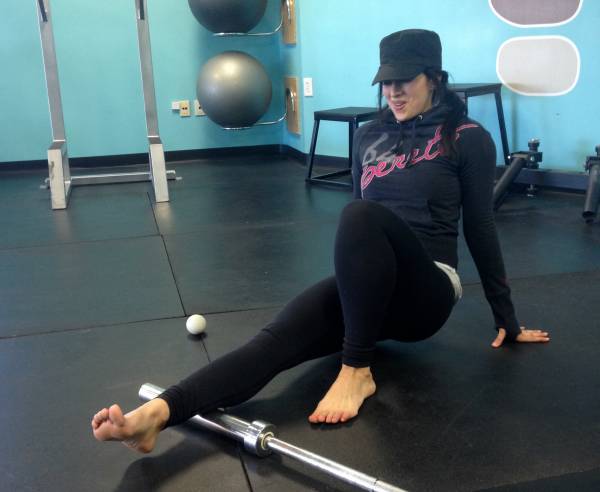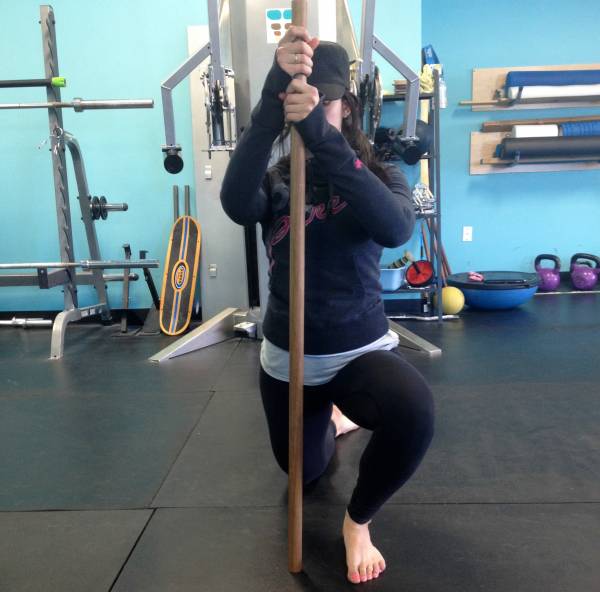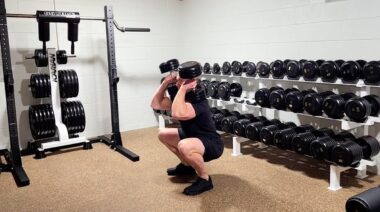Can you squat to parallel? Or do you struggle with obtaining that range of motion? If you struggle, or even if you can get all the way down but feel stiff doing so, then read on. I’m going to share six exercises that will help you get your squat to below parallel.
Common Squatting Errors
The squat is a powerful exercise that should be included in most training programs. It is one of the three big lifts in powerlifting, and it is a fantastic exercise to target not only the glutes, hamstrings, and calves, but also your entire body.
In addition, the squat can tell us a lot about your mobility, stability, and motor control. In fact, I look at the overhead squat of every client who walks into my physical therapy clinic so I can assess those three qualities.
But what happens if you can’t squat properly? There are a few common errors I see when it comes to squatting:
- Inability to squat below parallel (without the heels coming off ground)
- Knees caving in
- Upper back collapsing
If any of these sound familiar to you, you should work with a professional who can determine your issue and help you correct it. It could be as simple as training a different version of the squat (perhaps a goblet versus a back squat), or you may have to hone your work in on some more specific areas.
“I have taken someone who couldn’t squat to parallel and in thirty seconds had him squatting to his heels.”
Today we are going to focus on the first problem in that list – squatting to parallel – and the exercises you can do to remedy the problem. If you can’t squat below parallel (in other words, if your lift wouldn’t pass in a powerlifting meet), there could be a few reasons. The most common reasons are poor hip mobility, ankle mobility, or motor control.
Fix Those Hips
Poor hip mobility is most often due to poor postures and movement over time that have led to muscle imbalances and poor end-rage movement in the hip joint. At the bottom of a squat, you need to have a substantial amount of hip flexion. If this range is limited, you may not be able to hit parallel.
1. Foam Roll the Glutes and Piriformis
Sit on foam roller and cross your right ankle on your left knee as shown in the picture. Lean slightly to your right and roll your entire glute area. Do the same for your left side.
2. Hip Opener
This is a favorite of mine to open up the hips and work the end ranges of hip flexion. Go into a deep lunge with your back leg extended and knee resting on the ground. Place your hand on the inside of your front leg, holding your foot down, and use your elbow to push your knee out. Then, lean your body toward your front knee, moving around to really work that end range. Do this for about a minute and repeat on the other side.
A progression of this exercise is to do the same in the pigeon stretch. Make sure that you aren’t simply holding the exercise, but instead moving and leaning your body both toward and away from your front leg to really work the end range of the hip flexion.
3. Hip Flexor Stretch
This is a favorite hip stretch of mine. All you need is a stick or a foam roller. Check out this video for instructions.
Loosen Your Stiff Ankles
In order to obtain full range of motion, you need enough dorsiflexion at the bottom of your squat so your heels do not come off the floor. Dorsiflexion restrictions can be very evident in squatting, and these restrictions can occur due to an injury (new or old), tight or overactive calves, or improper footwear (heels, orthotics) to name a few causes.
4. Foam Roll Your Calves and Feet
You can use a foam roller, though I prefer to use a lacrosse ball or barbell as they are a little denser and get in a bit better. Simply sit on the floor with the roller or ball under your calves. From this point, you can either hold yourself up with your arms and roll the length of the calf or you can find a sore spot and make circles with your ankles to really get in there.

5. Dorsiflexion Ankle Mobility
Your initial set up will be the same as the hip flexor stretch demonstrated above, except you want to make sure the dowel or stick is directly in front of your big toe and just a couple inches away. Then, without allowing your front heel to come off the ground, lean forward so your knee travels toward the stick. When you can no longer do this without your heel leaving the ground, move forward so your knee goes just outside of the stick, continuing to lean forward as far as you can without your heel coming up. Repeat this for about ten reps, and you may or may not have to do this on both sides.

The Importance of Motor Control
Did you watch that self-test I included above? The overhead squat? Believe it or not, I have taken someone who couldn’t squat to parallel and in thirty seconds had him squatting to his heels. How?
I got him to do a simple exercise that fired up his central nervous system and got his stabilizer muscles working properly. This meant other muscles and joints didn’t have to take over and compensate for his poor motor control. The result? The full movemet done without difficulty. And the exercise he did was…
6. Bear Walks
The bear walk is such an excellent exercise for motor control that we include in warm up for all our athletes.
There you have it. Six exercises you can do to improve your squat range by improving your mobility, stability, and motor control. Which one worked for you? Post your results to the comments below.
Check out these related articles:






